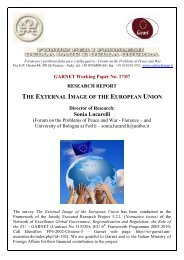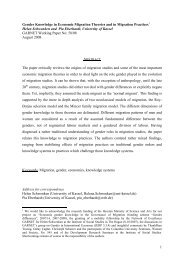GARNET Working Paper No. 13/07
GARNET Working Paper No. 13/07
GARNET Working Paper No. 13/07
Create successful ePaper yourself
Turn your PDF publications into a flip-book with our unique Google optimized e-Paper software.
But if it is not possible to conceive threat (or security) without incorporating the possibility of<br />
violence, could it be possible to conceptualize violence (or peace) without integrating the<br />
idea of threat The answer is negative. Even if we in theory could conceive of, for instance, a<br />
state being violently and suddenly attacked without the previous generation or perception of a<br />
latent threat, in practice this is virtually impossible to occur. In the complex world of<br />
international relations, the use of armed force is generally preceded by mounting exchanges<br />
of threats and the internalization of feelings of insecurity (even if minimal), which ultimately<br />
reinforce the idea that violence and insecurity need to be conceptualized unitarily.<br />
This argument can be taken further. As I pointed out earlier, the broad fields of security and<br />
peace shall not only be categorized by inimical relationships where threats and violence are<br />
produced and received 9 but, additionally, should also integrate the idea that the successful<br />
transformation of threats and violence endow an agent with the possibility to amplify and<br />
proactively generate more security and peace. In other words, peace and security allow to a<br />
wide range of different categorizations. If above I argued that the occurrence of a threat<br />
presupposed the possibility of using violence, would it be possible, following the same logic,<br />
to feel and magnify our security without peace The answer is obviously equally negative.<br />
The feeling of negative and positive security is dependent to a large extent on the principle<br />
that there is negative and structural peace. To feel secure or to be able to produce security,<br />
one needs to be certain of the impossibility of physical or structural violence to be inflicted<br />
on us. The contrary also holds. So that negative peace can be enjoyed between agents they<br />
need to be enveloped by a sense of security 10 . This rests on the underlying assertion that<br />
security is a prerequisite for the enjoyment of other values such as prosperity, freedom, and<br />
peace (Baldwin, 1997:18).<br />
The umbilical relationship between insecurity and violence can be further developed in the<br />
sense that structural violence, as defined above, could encompass the feeling of being under<br />
threat. Even if the threat does not materialize and violence is not materially inflicted (be it<br />
9 Obviously a crucial component of the process of production-reception of threats is deterrence. There are two forms of<br />
deterrence: deterrence by punishment or deterrence by denial. The first is a strategy by which governments threaten an<br />
immense retaliation if attacked. Aggressors are deterred if they do not wish to suffer such damage as a result of an<br />
aggressive action. The latter is a strategy whereby a government builds up or maintains defence and intelligence systems<br />
with the purported aim of neutralising or mitigating attacks. This study, however, is more concerned in ascertaining whether<br />
the production-reception of a threat (be it deterred or not) has a regional geographical component than to focus on<br />
mechanisms used to stop threats (which, in this case, would not aid us in identifying the regional component of security).<br />
10 This does not necessarily entail that the attainment of negative peace is inexorably associated to the reduction of<br />
insecurity. States might threat one another although they might not be willing to wage an armed conflict.<br />
11





